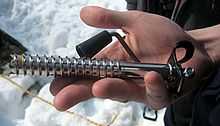Ice screw

An ice screw is a threaded tubular screw used as a running belay or anchor by climbers on steep ice surface such as steep waterfall ice or alpine ice during ice climbing or crevasse rescue, to hold the climber in the event of a fall, and at belays as anchor points.[1][2]
Design
Ice screws are made by several manufacturers. The various products available offer essentially similar functionality but typically offer subtle differences in design. For example, some ice screws come with one or more of the following: an in-built or separate ratchet mechanism to speed up placement, conical centre-hole to aid removal of ice cores, different lengths, different numbers of cutting teeth, different cutting angles, different surface finishes, different size hangers/clip holes. Price and durability are usually design considerations too, as a usable rack of ice screws will be a significant financial investment for many climbers. Titanium ice screws, often made in the former Soviet Union using Cold War-era missile technology, were generally too brittle and so the majority of ice screws are made of chromoly steel.
The strongest and most reliable type of ice screws currently available are the modern tubular ice screws which range in lengths from 10 to 23 cm. The approximate strength rating on a modern tubular ice screw is around 7 kN, although it has been found that short ice screws in "good" real-world ice hold about 7-8 kN, no matter what the fall factor or configuration is, according to research by Beverly and Attaway. The UIAA drop test uses a particularly taxing configuration for ice screws. That is, when multi-pitch lead climbing and the leader has only placed one screw (typically merely clipping one of the anchor screws) before climbing up a couple of meters and falling (i.e. fall factor 2). The dynamic ropes used in climbing can mitigate failure of an ice screw by keeping the impact forces low, especially if using a new rope that has not had any previous falls. It is rare that an ice screw fails in fall factors of 1 or less, if placed in good ice (which is why it is so important to place a screw or other running belay soon after starting a pitch).
An older type of screw that is rarely used today is a pound-in ice screw. Instead of screwing these into the ice one would pound them in with a mountaineering hammer or a hammer from the ice tool, and then screw them out to remove them. The pound-ins have been largely replaced by modern tubular ice screws that are stronger and easier to use. In the "Rosetta" project, the European Space Agency equipped its lander with multiple ice screws to obtain stability on comet surface, but they failed to hold and the lander bounced a significant distance from the initial landing site.
The latest ice screws incorporate replaceable tips, thereby increasing the useful life of the screw and enhancing placements.[3]
Placement
It was once thought necessary or beneficial for ice-screws to be place horizontally or more than horizontally (with the hanger up) for optimum hold. However, it has since been found experimentally that a screw place with the tip angled up often holds as well or better. This surprising result is thought to be due to the previously underestimated role of the threads in holding the screw in place. However, horizontal placements are usually recommended. Consult the manufacturers instructions.
Some climbers use tape slings to "tie-off" long ice-screws that have not been fully screwed into the ice, to reduce the leverage of a fall, which might bend or break the screw. There is some risk that such slings may move and/or be slice by the screw's hanger. Some novel ice screws include a hanger that can be moved down the shaft, instead of using a sling. Placing a shorter screw is usually the preferred option, hence various lengths are available.
Other uses
Long ice-screws are now often used to create V-threads (a type of thread-hole /ice-bollard). By making two ice-holes that intersect, an inexpensive but strong cord (typically static climbing accessory cord or tape, made of perlon, Dyneema or Specta) than be threaded through, making a relatively safe and cheap anchor. This can be an attractive option at belays and when ice screws are in short supply. V-threads can be particular useful as rappel/abseil points where it is often necessary to leave final anchor behind. A piece of wire - typically a piece of old coat hanger shaped for the purpose - or a stiff flexible purpose built tool with a small hook at one end and a hanging loop at the other end, is often used to aid threading of the cord, although it is not strictly necessary.
Manufacturers
References
- ↑ Cox, Steven M. and Kris Fulsaas, ed., ed. (2003-09). Mountaineering: The Freedom of the Hills (7 ed.). Seattle: The Mountaineers. ISBN 0-89886-828-9. Check date values in:
|date=(help) - ↑ Semet, Matt; Mike Tea (2011). Climbing Dictionary. Seattle, USA: The Mountaineers Books. p. 124. ISBN 1-59485-502-1.
- ↑ E-Climb: Ice Screw Replaceable Tips
External links
- Ice screw placement
- Negative (poor) angle placement
- Positive (good) angle placement
- Ice screw research by Beverly, M. M-PAS and Attaway, S. PhD1
- Video of ice screw placement
- Video of ice screw testing